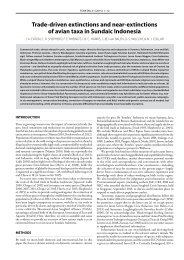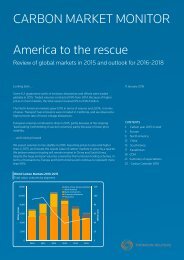Emissions Trading Worldwide
1TbjEHd
1TbjEHd
Create successful ePaper yourself
Turn your PDF publications into a flip-book with our unique Google optimized e-Paper software.
Korean <strong>Emissions</strong> <strong>Trading</strong> System (KETS)<br />
in force<br />
emissions coverage (Mtco 2 e, 2015)<br />
Liable entities<br />
573 525<br />
Gas coverage<br />
allocation<br />
Offsets & Credits<br />
several gases<br />
free allocation<br />
domestic offsets<br />
On 1 January 2015, the Republic of Korea launched its national ETS<br />
(KETS), the first nation-wide Cap-and-Trade program in operation<br />
in East Asia. The ETS covers approximately 525 of the country’s<br />
largest emitters, which account for around 68% of national GHG<br />
emissions. The KETS covers direct emissions of six Kyoto gases as<br />
well as indirect emissions from electricity consumption. The KETS<br />
will play an essential role in meeting Korea’s 2030 INDC target of<br />
37% below BAU emissions. In its first year of operation trade under<br />
the KETS has been limited. However, 2015 has seen a steady flow<br />
of credits from national offset projects.<br />
background information<br />
Overall Ghg <strong>Emissions</strong> (excl. LULUCF) 688.4 MtCO 2 e (2012)<br />
OVERALL GHG EMISSIONS BY SECTOR<br />
MtCO 2 e<br />
7.5 % 3.2 % 2 .2%<br />
73.4 %<br />
1.2 %<br />
12.5 %<br />
Phases and Allocation<br />
<strong>Trading</strong> periods Phase one: three years (2015–2017) Phase two: three years<br />
(2018–2020) Phase three: five years (2021–2025)<br />
allocation Phase one (2015–2017): 100% free allocation, no auctioning. Most<br />
sectors will receive free allowances based on the average GHG emissions of the<br />
base year (2011–2013). Three sectors (grey clinker, oil refinery, aviation) will be<br />
allocated free allowances following benchmarks based on previous activity data<br />
from the base year (2011–2013). During Phase one about 5% of total allowances<br />
are retained in a reserve for market stabilization measures (14 MtCO 2e), early<br />
action (41 MtCO 2e), and other purposes including new entrants (33 MtCO 2e). In<br />
addition, any unallocated allowances and withdrawn allowances will be transferred<br />
to the reserve. Phase two (2018–2020): 97% free allowances, 3% auctioned.<br />
Phase three (2021–2025): less than 90% free allowances, more than<br />
10% auctioned. Energy-intensive and trade-exposed (EITE) sectors will receive<br />
100% of their allowances for free in all phases. EITE sectors are defined along<br />
the following criteria: 1. additional production cost of >5% and trade intensity<br />
of >10%; or 2. additional production cost of >30%; or 3. trade intensity of >30%.<br />
COMPLIANCE PERIOD One year<br />
Industrial processes (51.37)<br />
Agriculture (21.99)<br />
Waste (14.81)<br />
Fuel combustion (ex. Transport)(505.57)<br />
fugitive emissions (8.32)<br />
transport (86.36)<br />
Flexibility<br />
GHG Reduction Targets By 2020: 30% below BAU. By 2030: 37% below BAU<br />
(536 MtCO 2e). This represents a 22% reduction below 2012 GHG levels.<br />
ets size<br />
Cap Phase one (2015–2017): 1,687 MtCO 2e, including a reserve of 89 million<br />
tCO 2e for market stabilization measures, early action and new entrants. 2015:<br />
573 MtCO 2e, 2016: 562 MtCO 2e, 2017: 551 MtCO 2e<br />
Caps for phase two and three have not yet been announced.<br />
emissions coverage<br />
covered<br />
not covered<br />
67.7%<br />
32.3 %<br />
GHG Covered CO 2, CH 4, N 2 O, PFCs, HFCs, SF 6<br />
Sectors & THRESHOLDS Phase one (2015–2017): 23 sub-sectors from steel,<br />
cement, petro-chemistry, refinery, power, buildings, waste and aviation sectors.<br />
inclusion Thresholds: Company >125,000 tCO 2/year, facility >25,000 tCO 2/year<br />
Point of regulation Downstream<br />
Number of liable entities 525 business entities including 5 domestic airlines.<br />
Banking and borrowing Banking is allowed without any restrictions.<br />
Borrowing is allowed only within a single trading phase (maximum of 10% of<br />
entity’s obligation), not across phases.<br />
Offsets and Credits Phase one (2015–2017) and Phase two (2018–2020):<br />
Qualitative limit: Only domestic credits from external reduction activities<br />
implemented by non-ETS entities — and that meet international standards<br />
— may be used for compliance. Domestic CDM credits (CERs) are allowed<br />
in the scheme. Eligible activities include those eligible under the CDM and<br />
Carbon Capture and Storage (CCS). However, only activities implemented after<br />
14 April 2010 are eligible. Quantitative limit: Up to 10% of each entity’s compliance<br />
obligation. Phase three (2021–2025): Up to 10% of each entity’s compliance<br />
obligation with a maximum of 5% coming from international offsets.<br />
PRICE MANAGEMENT PROVISIONS The Allocation Committee may decide to<br />
implement market stabilization measures in the following cases: 1. The market<br />
allowance price of six consecutive months is at least three times higher than<br />
the average price of the two previous years. 2. The market allowance price of<br />
the last month is at least twice the average price of two previous years and<br />
the average trading volume of the last month is at least twice the volume of<br />
the same month of the two previous years. 3. The average market allowance<br />
price of a given month is smaller than 40% of the average price of the two previous<br />
years. In 2015 and 2016, the price threshold is KRW 10,000 (EUR 7). The<br />
stabilization measures may include: 1. Additional allocation from the reserve<br />
(up to 25%) 2. Establishment of an allowance retention limit: minimum (70%)<br />
international carbon action partnership<br />
57




